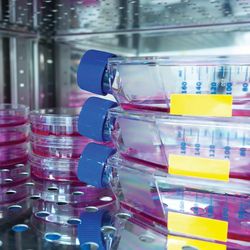Exploring Extracellular Vesicles with Flow Cytometry
Flow cytometry-based approaches can advance our understanding of the diagnostic significance of extracellular vesicles

Extracellular vesicles (EVs) have recently been recognized as potential biomarkers in cancer and other diseases. However, isolating and analyzing exosomes can be challenging. Flow cytometry-based approaches offer an effective and convenient method to study EVs in biological fluids and more complex human samples, facilitating the simultaneous detection of multiple markers on hundreds of thousands of EVs.
What are EVs?
"Flow cytometry-based approaches can help advance our understanding of the diagnostic and therapeutic significance of extracellular vesicles, especially exosomes, which hold promise as disease biomarkers."
Cell-derived small particles carry a collection of valuable information that can be analyzed by flow cytometry. Small particles include platelets (typically about 2–3 µm in diameter), bacteria ranging from 0.3 µm to 5 µm, and EVs. Cells secrete three main subtypes of EVs into the extracellular space: apoptotic bodies, microvesicles, and exosomes, which are distinguished based on their origin, size, physical properties, and function. Apoptotic bodies can measure up to 5 µm in diameter and are released from cells undergoing programmed death. Microvesicles are usually 100 nm to 1 µm in diameter and are formed by direct budding from the plasma membrane. Exosomes, the smallest type of EVs, are produced in the endosomal compartment of most cells and can be as small as 50 nm in diameter.1,2

The importance of cell-derived EVs in biological and pathological processes
Scientists and physicians have grown interested in EVs over the past decade in response to discoveries that these small particles are abundantly present in body fluids, carry proteins, nucleic acids, and other cellular components, and participate in intracellular communication in relevant biological processes, including apoptosis, antigen presentation, angiogenesis, inflammation, and coagulation.3–5 Considering the importance of cell-derived EVs in multiple biological processes, their role in pathological conditions is a topic of increasing relevance in biomedical research.
For example, isolation and characterization of exosomes from body fluids can provide valuable information for early detection and disease monitoring, especially in cancer. Cancer-related exosomes are produced by cancer cells or tumor microenvironment-associated cells. The content of these exosomes—including proteins, DNA, mRNA, microRNA, long noncoding RNA, and circular RNA—contributes to regulating tumor growth, metastasis, and angiogenesis, which is useful for early cancer detection and prognosis, as well as the evaluation of therapeutic efficacy.6 Exosomes have also been reported to aid in the spread of pathological proteins involved in neurodegenerative diseases, including Alzheimer’s, Parkinson’s, and Huntington’s disease.7
"As commercial instruments designed to measure small particles become available, flow cytometry-based approaches can help advance our understanding of the diagnostic and therapeutic significance of EVs."
EVs can also deliver a wide range of molecules to nearby targets or distant sites within the intracellular space. Moreover, they are stable in the blood and can travel long distances within the circulatory system under both physiological and pathological conditions. These characteristics can be helpful for the development of therapeutic strategies, such as exosome-based vaccines against different types of infectious diseases and exosome-based immunotherapy.8,9
Drawbacks to current methods of EV detection
The heterogeneity of EVs has made their study challenging. Most EV studies have used bulk analyses such as Western blot, ELISA, or mass spectrometry proteomics. Although these methods are conceptually simple, versatile, and relatively inexpensive, they only report the average properties of EV samples. Moreover, EV sample preparation using these techniques requires multiple steps and is time consuming. Other methods, such as nanoparticle tracking analysis (NTA) and asymmetrical-flow field-flow fractionation (AF4) can monitor the presence, size, and quantity of EVs, but require a specialized and highly skilled operator. These advanced characterization methods, especially NTA, may also not be affordable or available to all laboratories.10
Flow cytometry to resolve exosomes: improving on current detection methods
Exosome isolation
Flow cytometry, a technique for quantitative single-cell analysis, has a high potential for the study of EVs. Good sample preparation is critical to accurate cytometry, and differential ultracentrifugation is the classic method for EV separation from conditioned media or biofluids. Differential ultracentrifugation separates sample particles into fractions according to their different sizes and masses, producing a pellet and supernatant (remaining sample fluid). The first low-speed centrifugation steps remove nonadherent cells, dead cells, and cellular debris. The remaining supernatant is then centrifuged at 100,000g to pellet exosomes. The pellet is resuspended in an appropriate medium such as phosphate-buffered saline (PBS) and centrifuged a second time at 100,000g to reduce contamination. This final pellet, consisting of isolated exosomes, is again resuspended and can be analyzed by flow cytometry.11

Analyzing exosomes via flow cytometry
When using a flow cytometer, samples are suspended in fluid and passed through a focused laser beam. Cells and fluorescently labeled cell components—including membranes, cell surface and intracellular proteins, and DNA—are excited and emit light, which is detected by a series of photodiodes and amplified. The resulting electrical pulses are digitized, and the data is stored, analyzed, and displayed through a computer system.
The robust statistical power and the ability to analyze multiple parameters make flow cytometry a valuable technique to analyze and characterize EVs.10 However, conventional flow cytometers may not appropriately detect single vesicles smaller than 500 nm due to their small size and low refractive index.12,13 The use of microbeads attached to the EVs can overcome this limitation, allowing semiquantitative analysis.10
Currently, high-resolution flow cytometry is the most promising method to characterize EVs. High-resolution flow cytometry integrates high-power lasers and special modifications of the optical detection system, enhancing the scatter intensity and fluorescence signals coming from the EVs. Using immunofluorescent antibodies that target EV-associated membrane proteins, this high-throughput, multiparameter technique enables the analysis of specific EV subpopulations as small as 50 nm.14 Therefore, high-resolution flow cytometers can detect and phenotype the full range of EVs isolated from biofluids and more complex human samples, including specific subpopulations of cancer cell-derived EVs.
Available high-resolution flow cytometers, like the A60-Micro-PLUS (Apogee Flow Systems, Hemel Hempstead, UK), are intended for research use only, but commercial flow cytometers capable of this level of resolution will likely soon be on the market.
Elucidating the diagnostic and therapeutic potential of EVs
Despite the technical and biological challenges associated with the characterization of EVs, flow cytometry principles are generally applicable to their analysis. As commercial instruments designed to measure small particles become available, flow cytometry-based approaches can help advance our understanding of the diagnostic and therapeutic significance of EVs, especially exosomes, which hold promise as disease biomarkers.
References:
1. Doyle LM, Wang MZ. Overview of extracellular vesicles, their origin, composition, purpose, and methods for exosome isolation and analysis. Cells. 2019;8(7):727. doi:10.3390/cells8070727
2. Cloet T, Momenbeitollahi N, Li H. Recent advances on protein-based quantification of extracellular vesicles. Anal Biochem. 2021;622:114168. doi:10.1016/j.ab.2021.114168
3. Nolan JP, Duggan E. Analysis of individual extracellular vesicles by flow cytometry. Methods Mol Biol. 2018;1678:79-92. doi:10.1007/978-1-4939-7346-0_5
4. Yáñez-Mó M, Siljander PR-M, Andreu Z, et al. Biological properties of extracellular vesicles and their physiological functions. J Extracell Vesicles. 2015;4:27066. doi:10.3402/jev.v4.27066
5. Simons M, Raposo G. Exosomes--vesicular carriers for intercellular communication. Curr Opin Cell Biol. 2009;21(4):575-581. doi:10.1016/j.ceb.2009.03.007
6. Dai J, Su Y, Zhong S, et al. Exosomes: key players in cancer and potential therapeutic strategy. Signal Transduct Target Ther. 2020;5(1):145. doi:10.1038/s41392-020-00261-0
7. Rastogi S, Sharma V, Bharti PS, et al. The evolving landscape of exosomes in neurodegenerative diseases: exosomes characteristics and a promising role in early diagnosis. Int J Mol Sci. 2021;22(1):440. doi:10.3390/ijms22010440
8. Santos P, Almeida F. Exosome-based vaccines: history, current state, and clinical trials. Front Immunol. 2021;12:711565. doi:10.3389/fimmu.2021.711565
9. Xu Z, Zeng S, Gong Z, Yan Y. Exosome-based immunotherapy: a promising approach for cancer treatment. Mol Cancer. 2020;19(1):160. doi:10.1186/s12943-020-01278-3
10. Serrano-Pertierra E, Oliveira-Rodríguez M, Matos M, et al. Extracellular vesicles: current analytical techniques for detection and quantification. Biomolecules. 2020;10(6):824. doi:10.3390/biom10060824
11. Gardiner C, Di Vizio D, Sahoo S, et al. Techniques used for the isolation and characterization of extracellular vesicles: results of a worldwide survey. J Extracell Vesicles. 2016;5:32945. doi:10.3402/jev.v5.32945
12. Böing AN, van der Pol E, Grootemaat AE, Coumans FAW, Sturk A, Nieuwland R. Single-step isolation of extracellular vesicles by size-exclusion chromatography. J Extracell Vesicles. 2014;3. doi:10.3402/jev.v3.23430
13. Chandler WL, Yeung W, Tait JF. A new microparticle size calibration standard for use in measuring smaller microparticles using a new flow cytometer. J Thromb Haemost. 2011;9(6):1216-1224. doi:10.1111/j.1538-7836.2011.04283.x14.
14. Welsh JA, Holloway JA, Wilkinson JS, Englyst NA. Extracellular vesicle flow cytometry analysis and standardization. Front Cell Dev Biol. 2017;5:78. doi:10.3389/fcell.2017.00078

